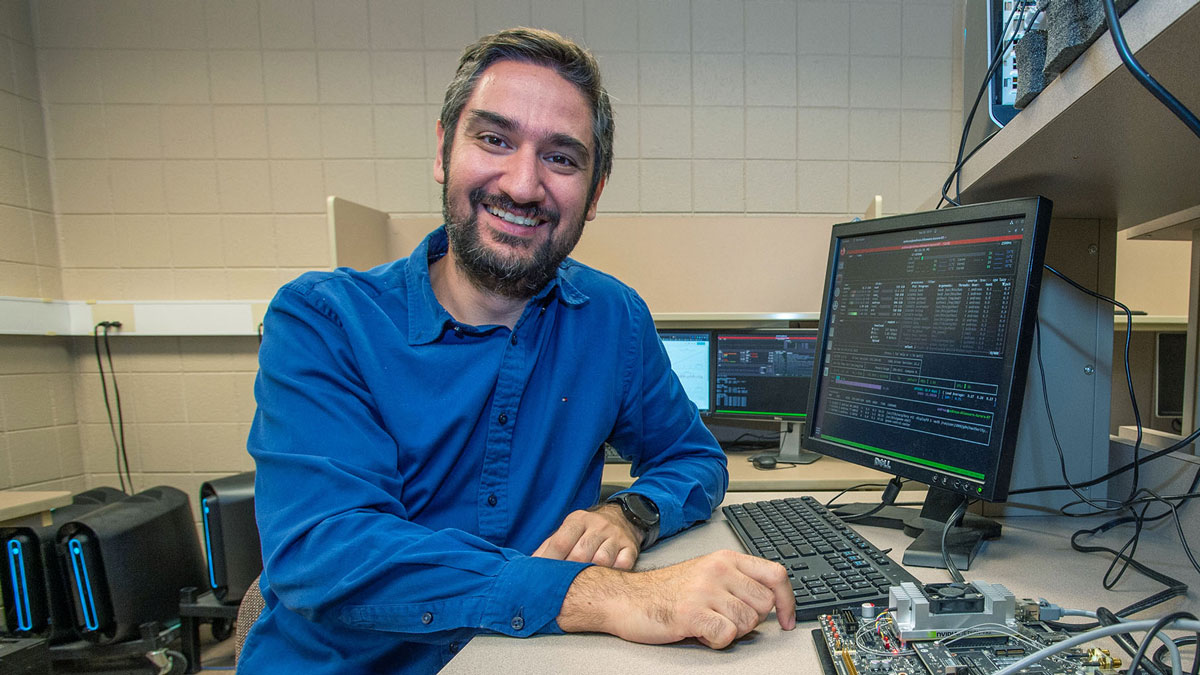
Iraklis Anagnostopoulos, an associate professor in the School of Electrical, Computer and Biomedical Engineering at SIU Carbondale, recently received a three-year, $588,000 grant from the National Science Foundation to study substantially improving the sustainability of modern edge data centers by mitigating the environmental impact of AI and boosting the efficiency of data processing. (Photo by Russell Bailey)
October 10, 2023
SIU prof gets $588K grant to shrink AI’s carbon footprint
CARBONDALE, Ill. – Big data and big AI need big power to operate. That’s why a researcher at Southern Illinois University Carbondale is studying ways to make this growing tech sector greener.
Iraklis Anagnostopoulos, an associate professor in the School of Electrical, Computer and Biomedical Engineering, recently received a three-year, $588,000 grant from the National Science Foundation to study substantially improving the sustainability of modern edge data centers by mitigating the environmental impact of AI and boosting the efficiency of data processing.
The AI market is anticipated to expand tenfold into a sector worth hundreds of billions of dollars within the next five years, Anagnostopoulos said. But the rapid expansion of this type of technology has caused apprehension about its impact on climate change.
“AI has enormous potential to positively influence society, and it’s projected to grow considerably in the coming years,” he said. “But along with this rapid expansion of AI technologies are issues with a considerable environmental impact and raised concerns about their associated operational and embodied carbon footprints. The former is associated with their ongoing operation and maintenance while the latter with the entire life cycle of the devices.”
Big power
AI, big data and the massive server farms that power them use a lot of electricity.
“The primary concern here is the energy required for the computation and data processing tasks,” Anagnostopoulos said. “These operations are usually carried out in large data centers that consume enormous amounts of electricity.”
Beyond simply powering the servers, operators must expend significant energy to cool the data centers, which necessarily create heat. The server environment must maintain a certain temperature to ensure they function optimally.
Network infrastructure that operates cloud-based storage and real-time data analytics also contributes to the growing carbon footprint in this sector, Anagnostopoulos said.
“The central aim of our research is to improve the sustainability by using extensive, multilayered optimizations of edge data centers,” he said. “Unlike conventional data centers, edge data centers are designed to be closer to end-users and able to harness renewable energy for their operations.”
Taking a high-tech approach
Optimization of edge data centers would enable a more localized computing infrastructure, Anagnostopoulos said. His research would move beyond traditional optimization methods and target “vertical solutions” for specific sectors of the infrastructure to improve the efficiency at each stage.
“There are multiple parameters that affect operational and embodied carbon footprints,” he said. “We’re trying to find ways of lessening the operational carbon footprint by harnessing renewable energy sources, enhancing power usage efficiency and strategically distributing workload across various computing components.”
At the same time, other ways to decrease the carbon footprint include down-scaling energy-efficient hardware accelerators, which are specialized units designed to perform specific functions more efficiently than a general-purpose central processing unit. Tensor processing units, a subcategory of these, are designed to accelerate machine learning calculations and are critical in speeding up computationally intensive tasks and making data processing more efficient.
“Developing reliable hardware accelerators and efficiently utilizing computing resources lead to more energy-efficient data centers,” Anagnostopoulos said. “It reduces the carbon footprint and improves their overall sustainability.”
Downscaling hardware accelerators would help reduce carbon in several ways.
First, smaller hardware accelerators often are designed to be more energy-efficient, using less power per computation. They also typically require fewer materials to manufacture, decreasing the rare-earth materials often needed in semiconductor manufacturing. Such efficiently designed hardware is often more reliable and has a longer lifespan, as well.
“Striking a balance between performance and the need for downscaling hardware is a difficult challenge,” Anagnostopoulos said. “The goal is to optimize hardware designs in a way that minimizes environmental impact without compromising the performance requirements essential for specific tasks.”
Anagnostopoulos hopes the work ultimately will promote the adoption of sustainable practices in the computing industry as a whole.
“We want to contribute to a broader paradigm shift toward embracing eco-friendly practices in the computing domain that will drive digital infrastructure’s transition towards a greener and more sustainable future,” he said.
